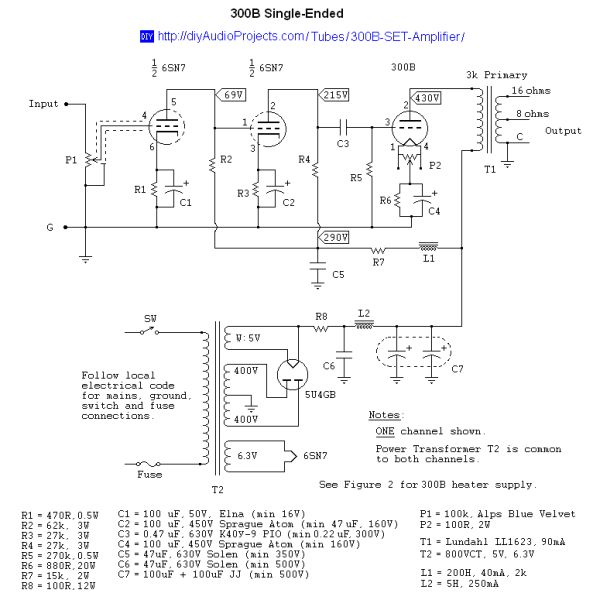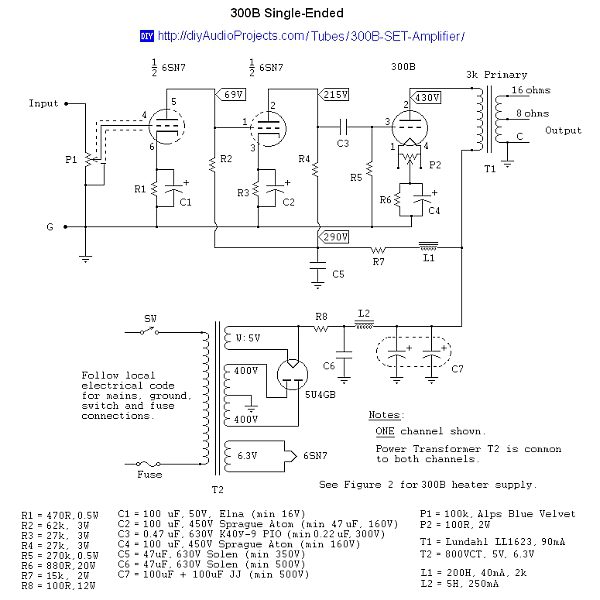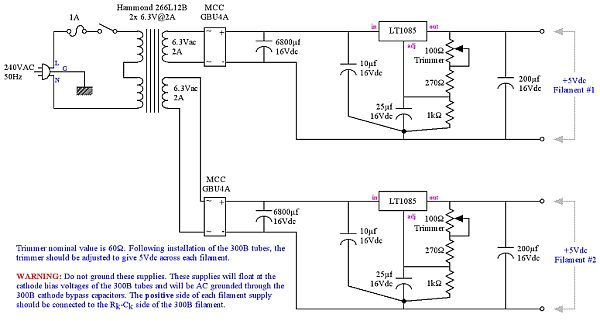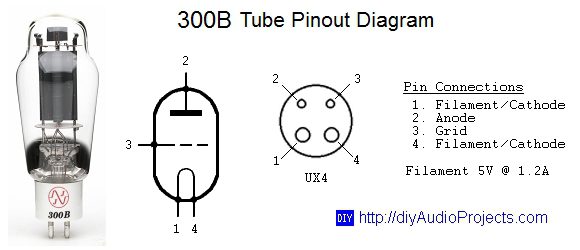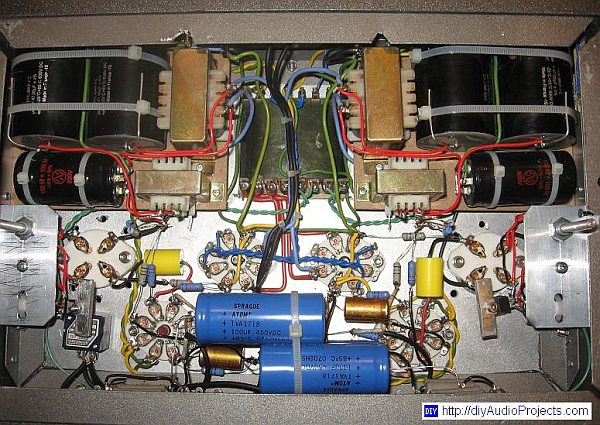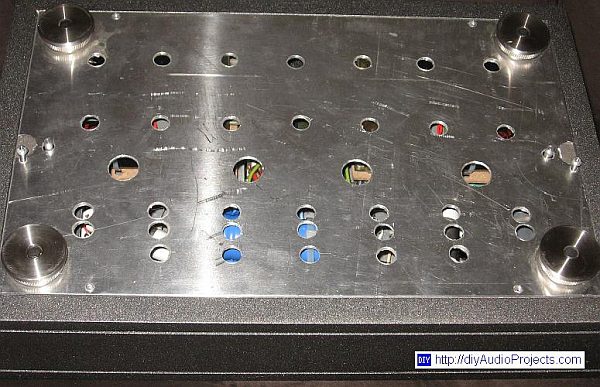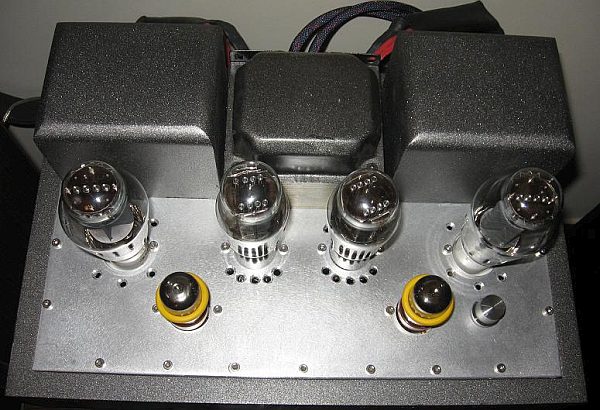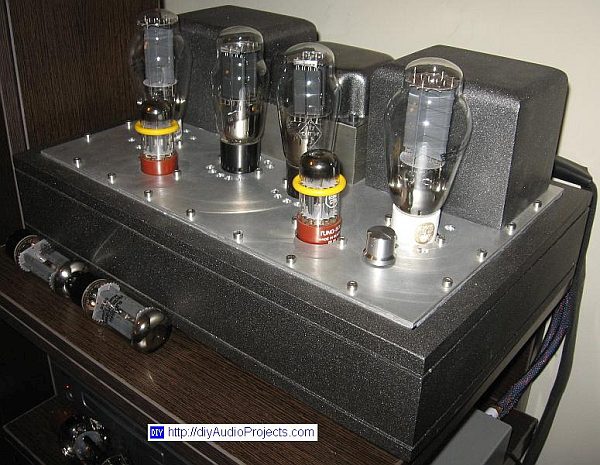This DIY 300B triode amplifier project was completed by Stamou Tasos who is from Greece. As a thank you for the 300B amplifier schematics, Stamou has shared with us his implementation of the 300B single-ended (SE) tube amplifier schematic by J.C. Morrison. I have assisted by translating, fromating and presenting his DIY 300B triode amplifier project. – Giovanni Militano – Editor
The circuit that I decided to follow for my 300B triode amplifier I found on this site, the 300B Single-Ended (SE) tube amplifier schematic with direct coupled 6SN7 input stage. Please take a look at the SE 300B schematic for a description of Mr. J.C. Morrison’s SE 300B tube amplifier circuit which I will refer to as the “original schematic”. Specifically recommended in the circuit notes was that premium output transformers and components be used for the 300B amplifier build. For this SE 300B triode tube amplifier build I have used premium parts throughout, Lundahl audio output transformers and a DIY chassis. This 300B Single-Ended-Triode (SET) amplifier circuit uses a direct coupled 6SN7 driver stage. The output stage is a SE 300B triode and the maximum power output is about 8 Watts per channel. A pair of reasonably sensitive (~91 dB+) loudspeakers will be required with this 300B SET amplifier.
The exact values and brands of the parts that I used for my SE 300B triode amplifier build are shown in Figure 1. You should expect that the values of R7 and R8 will need to be adjusted slightly in order to achieve the target voltages shown in the schematic. The schematic shown in Figure 1 is for one channel only with the exception of the power transformer (T2) which is shared between both amplifier channels. Keep this in mind as you are making up a parts order list for this 300B SET amplifier project. The voltages noted in Figure 1 are measurements from my 300B triode amplifier build and compare closely to the voltages shown on the original SE 300B schematic. The voltage at these test points will change slightly with different tubes sets so don’t expect to match the shown voltages exactly. Remember that the maximum anode voltage for the 300B triode tube is 450V.
I did not deviate all that much from the original SE 300B schematic that I was following. To adjust the B+ I introduced a resistor in the power supply (R8). For improved performance an anode choke (L2) was been added to each channel. R7 was adjusted from the original value of 27k to 15k to attain the target voltages. To further improve performance from this 300B triode amplifier the power supply filtering sections have been duplicated for each channel. While the power transformer (T2) is shared between both channels, each audio channel has separate rectifier, chokes and filter capacitors. Using a separate tube rectifier (5U4-GB) for each channel results in a decreased voltage loss across the tube rectifier. For more detailed information on tube rectified power supplies see these notes on vacuum tube power supply design. The 300B tube anodes are at 430V. By reducing the size of R8 you can increase the B+, but note that the maximum anode voltage for the 300B triode tube is 450V.
For the audio output transformers (T1) I used Lundahl LL1623 Transformers (90mA) – PDF (52kB). In my experience, a high quality audio output transformer is required for superior performance with SE tube amplifier circuits. Lundahl is a leading manufacturer of audio transformers and the Lundahl LL1623 transformers uses a special audio C-core. The power transformer and chokes are from a local manufacturer here in Greece and built to custom specification. For the small anodes chokes I specified 200H, 40mA (L1) and for the tube power supply chokes 6H, 225mA (L2). The power transformer (T2) has many taps specified as 400-0-400 @ 250mA, 6.3V @ 2A, 6.3V @ 2A, 6.3V @ 2A, 5V @ 3A, 5V @ 3A. The power transformer (T2) is shared between both audio channels of the SET amplifier.
In the original SE 300B schematic a solid state filtered DC power supply is used for the 300B filaments. To improve on this idea I decided to use 5V integrated circuit (IC) voltage regulators for the 300B filament supply. In my initial attempt I tried two 7805 voltage regulators in parallel for each channel but the current draw from the 300B heater filaments was too large for the 7805 IC. In an email exchange with Gio he recommended that I try the LT1085 voltage regulator circuit shown in Figure 2 for the 300B filaments. This 5V regulated power supply for the 300B filaments was posted by Suncalc and details about the regulated circuit are in the 300B SET Design Project forum thread. With the LT1085 regulator circuit in place the 5V filament supply was stable and the 300B SET amplifier was whisper quiet. I used a separate LT1085 regulated power supply circuit for each audio channel. Note that I did not use the Hammond transformers shown in the Figure 2 Schematic. The LT1085 regulated power supply circuit is connected to the 6.3V taps from the power transformer (T2).
Building the 300B Single-Ended-Triode Amplifier
The 300B SET amplifier was built using point-to-point construction. The premium capacitors are very large in physical size so you will need to use a good sized enclosure for the amplifier. I spent a long time planning the layout of the 300B SET amplifier as you need to be careful so not to create ground loops in your amplifier build. For more information about grounding, see this helpful article about grounding and shielding for your DIY audio projects. Photograph 2 shows the 7805 regulators I initially tried for the 300B filament circuit. The long shafts on the left and right edges of Photograph 2 are from the 300B hum potentiometers (P2). For the internal input cable wiring I used Mogami W2330 shielded interconnect wire.
Warning: This 300B SET amplifier project uses voltages which are in excess of the 400 Volt range. Contact with voltages of this magnitude can cause serious injury or possibly be fatal. If you do not know how to build projects that have these potentials or you are not comfortable in with projects that use these high voltage levels, it is strongly recommended you do not built this vacuum tube amplifier. You must follow your governing electrical codes for all grounding, wiring and connections.300B Single-Ended-Triode Amplifier – Inside and Back
You will notice that I have drilled a number of ventilation holes in the bottom plate (Photograph 4). This is where cool air will enter the amplifier. The hot air will rise and exhaust through the ventilation holes in the top plate (Photograph 5). Please be sure to consider ventilation when you are planning your 300B triode amplifier build.
The finished amplifier is shown in Photograph 5. I made wooden MDF covers for the Lundahl audio output transformers. The MDF wooden frame and transformer covers were primed and painted with spray cans. In the end I was very pleased with how my chassis turned out for the 300B SET amplifier.
Sound – 300B Single-Ended-Triode Amplifier
I was so eager to hear this 300B triode amplifier that I just had to have a listen before it was even complete. Photograph 6 below shows my first listening session with the 300B SET amplifier. At this point, the amplifier had not yet been finished still requiring the transformer covers and ventilation holes in the top plate. The tube compliment was Electro Harmonix 300B Gold Grid, Electro Harmonix 5U4GB and Tung-Sol 6SN7GTB. For the 6SN7 driver tube I also tried NOS Sylvana and RCA tube brands, and I found that I like the sound from Tung-Sol brand tubes the best. The speakers shown in Photograph 6 are DIY double horn enclosures with the Fostex FE207E fullrange driver.
It really is a pity you that you cannot hear for yourself how wonderful this DIY 300B SET amplifier sounds. We made a direct comparison against the Sofia Electric SET 300B equipped with JJ 300B triode tubes. We tested both triode amplifiers against Lowther DX3 horn speakers and Spicom Planar F3 (Dipole floorstanding speaker with 25″planar driver). With all of the many tube and speaker combinations that we tried, every time we found that we both preferred the sound quality from my DIY 300B SET amplifier over that of the Sofia Electric SET 300B. This is a great sounding 300B triode amplifier that I am sure DIYers will find to be very rewarding.
The finished amplifier is shown above in Photograph 7. I am really pleased with how the 300B SET amplifier build turned out both aesthetically and sonically. I’d like to thank the website for providing the schematics to build such a wonderful sounding 300B triode amplifier.
Source: DIY 300B Single-Ended-Triode (SET) Hi-Fi Amplifier

